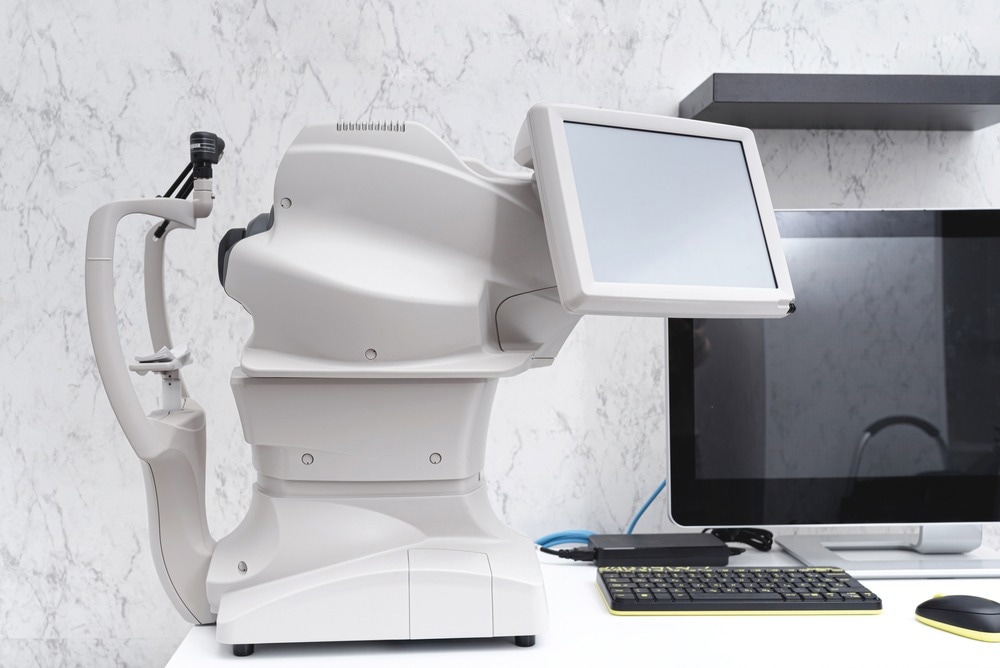A study published in Diagnostics investigated and characterized corneal morphological changes that occur in the first 17 hours after death using portable optical coherence tomography. This study will have significant implications in forensic pathology.

Study: The Influence of Eyelid Position and Environmental Conditions on the Corneal Changes in Early Postmortem Interval: A Prospective, Multicentric OCT Study. Image Credit: Focus and Blur/Shutterstock.com
Cornea and Corneal Opacity
The cornea is the transparent, dome-shaped area of the eye that protects the iris, pupil, and anterior chamber. The cornea must remain clear so light can pass through it before reaching the retina.
Corneal opacity occurs when the cornea becomes scarred. This prevents light from passing through the cornea to the retina, causing the cornea to appear white or cloudy.
Corneal Opacity in Forensic Pathology
The macroscopic phenomena of postmortem corneal opacification are characterized abundantly in forensic research and are significant to every professional involved in corneal transplant and forensic pathology.
However, few researchers have examined this phenomenon's genesis in depth. This is owing to various factors, including the disfigurement created by postmortem enucleation and the requirement for exceptional levels of knowledge to undertake histological or immunohistochemical investigations on corneal tissue.
Therefore, forensic research on the eye during postmortem intervals concentrated nearly solely on biochemical changes influencing the aqueous and vitreous parts of the eye.
Optical Coherence Tomography for Ocular Surface and Corneal Diseases
Optical coherence tomography (OCT) is a relatively new and quick imaging method that uses infrared light to evaluate several ocular components in real time. Since 1994, this interferometric technique has been utilized to investigate the human eye and has steadily developed into a valuable diagnostic tool in clinical settings.
In forensic pathology, the reliability and feasibility of this innovative technology for studying the cornea in situ after death has been examined through a series of experiments using human and animal samples.
In ophthalmology, diagnostic and forensic imaging tools based on OCT have become essential in studying the anterior chamber and retina.
Using OCT to Investigate Postmortem Ocular Changes and Tissue Alterations
Researchers examined 46 corneas from 23 subjects using portable optical coherence tomography (OCT) in a multicenter environment within the first 17 hours following death.
The right eye was kept closed in all bodies while the left was left open using appropriate supports. The experiment was conducted on 11 samples in winter and 12 in summer.
The first 17 hours postmortem were allocated for a portable spectral-domain OCT instrument to perform corneal imaging every hour to assess the effects of ambient factors and eyelid opening on the onset of tissue alterations.
Significant Findings of the Study
The swelling and dehydration of the stroma in closed eyes have a significant role in postmortem corneal changes. In the early endothelial decompensation, the eyelid closure state does not affect corneal morphology. However, after 3 hours, the dehydration becomes prominent, encouraging the tissue's morphological modification.
Influence of environmental conditions: humidity and temperature
Temperature and humidity have a crucial impact, especially when the eye is completely open and exposed to the air. However, in this study, scans of the samples were not affected by these factors as they were conducted at controlled temperatures.
However, comparing the pachymetric maps at higher temperatures reveals slight anticipation of the phenomenon in the open eyes. In contrast, the phenomenon seems almost ineffectual when OCT scanning is performed on a closed eye. This means the hypoxic/anoxic postmortem condition is likely the primary mechanism causing the tissue alterations.
Limitations of the study
Due to ethical considerations, researchers could not analyze the bodies from the precise time of death, and the state of eyelid closure between 0 and 1.5 h after death was random.
The number of observations should have included individuals with systemic and ocular pathologies to verify their impact on the reported phenomena.
The investigation was conducted at a controlled temperature and within a specific range, which limited the examination of the effects of extremely low or extremely high temperatures, ventilation, and humidity on the development of the alterations.
Future directions
This research will have substantial implications for forensic pathology for determining the transplantation and postmortem interval to improve tissue preservation before explant. However, further research is needed before the technology can be used for thanato-chrono-diagnosis in forensic pathology and tissue conservation for corneal transplantation.
Reference
Nioi, M., Napoli, P.E., Demontis, R., Chighine, A., De-Giorgio, F., Grassi, S., Scorcia, V., Fossarello, M., & d’Aloja, E. The Influence of Eyelid Position and Environmental Conditions on the Corneal Changes in Early Postmortem Interval: A Prospective, Multicentric OCT Study. Diagnostics. https://www.mdpi.com/2075-4418/12/9/2169/htm
Disclaimer: The views expressed here are those of the author expressed in their private capacity and do not necessarily represent the views of AZoM.com Limited T/A AZoNetwork the owner and operator of this website. This disclaimer forms part of the Terms and conditions of use of this website.